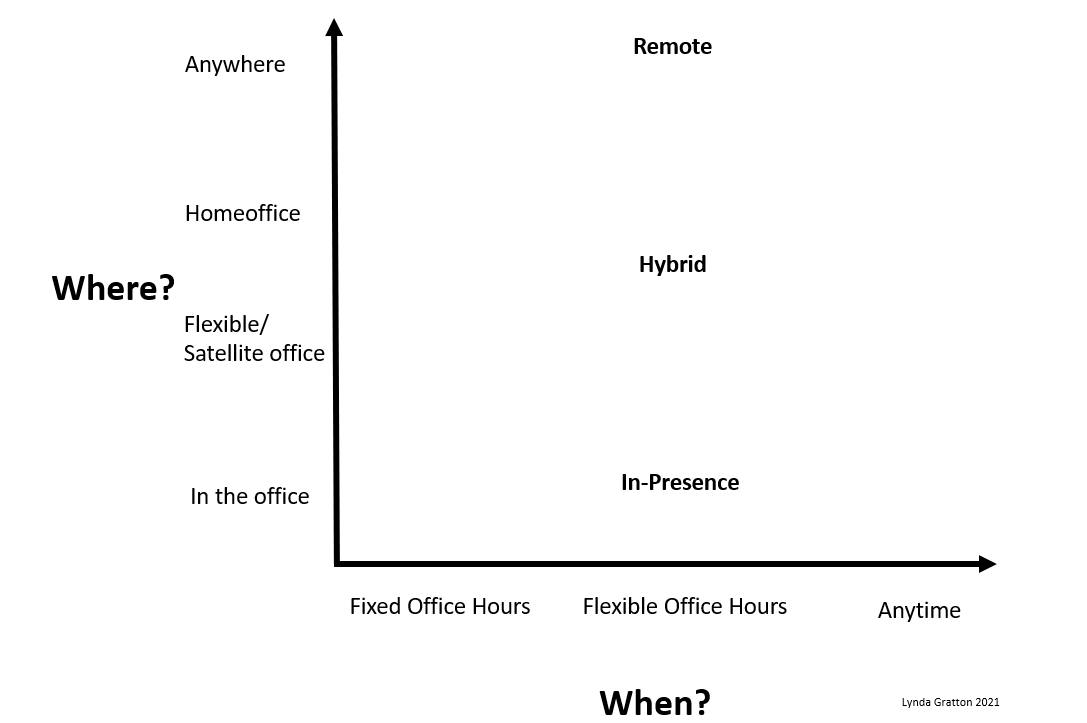One thing is clear: employees want the best of both worlds. Several studies show that most employees still want flexible remote work opportunities (also after the pandemic will have ended), yet 67% miss direct contact with their colleagues. 80% of executives expect more flexible policies to work from home after the pandemic.
We show what needs to be considered in the transition to a hybrid workplace model, what role the office will play in the future and, in particular, why the future of work puts individual freedom of choice in the foreground.
Hybrid or virtual working models are on the rise due to several factors: the generational change in the labor market, accelerated by the corona pandemic and the associated, mostly forced “home office”, companies and employees now see themselves in the situation of having to create a new reality of collaboration! Organizations that considered mobile working as “impossible” before the pandemic, were last year taught a lesson: mobile work INDEED IS possible and, in many cases, far better than anyone might have ever thought. Many companies are now moving to hybrid work environments with various work-from-home options. However, studies clearly show that it is not so easy to implement a successful hybrid model, because dictating to employees how many days a week they must be physically present in the office is not enough.
The advantages of hybrid organizations seem obvious: On the employee side, a higher work-life balance ensures greater satisfaction, the time saved by at least partially eliminating commute times reduces stress and costs. Individual time management allows more flexibility in childcare and thus leads to an increase in equal opportunities. All these factors contribute to higher motivation, more loyalty to the company and an increase in efficiency.
On the employer side, these factors are reflected in potential cost reductions through lower room rent and reduced energy consumption. Furthermore, companies can rely on talents and experts from a larger geographical area and cooperation from different locations is more efficient and effective. Seemingly a win:win situation. At a closer look, however, it becomes clear that hybrid working models pose challenges for employees as well as for companies. While the change to the “home office” at the beginning of the pandemic was a sudden, forced one, we are now in the situation of being able to implement a sustainable new way of working in an intentional and planned manner.

1 What are hybrid teams?
The corona pandemic has forced companies and teams primarily into virtual structures: a working environment in which there are no common physical locations, all employees connect solely via virtual tools. In contrast to virtual teams, in hybrid teams one or more team members are completely or at least partially together in one physical place. Communication runs asynchronously or synchronously in virtual, hybrid or face-to-face meetings.
One of the most common variants is the one in which teams have a common office as a home base but are not constantly present together. Variations from “remote days” for individuals to “100% remote employees” are possible. In between, there are many variations. In extreme cases, there is a complete dissolution of the physical office and selective meetings even occur in rented premises. More common approaches include individual team members with fixed days but are basically free in the choice of working hours and place of work. The following figure shows the possibilities of different settings taking into consideration the “WHERE?” and “WHEN?”, from “in the office with fixed times” to a “wherever and whenever I want”:

2 What are the leadership requirements to be able to work successfully in hybrid teams?
Like any kind of change, the shift to hybrid work environments is primarily, but not exclusively, a leadership issue. A fundamental change like this also requires a – often fundamental – change in the corporate culture. For managers, several levels must be considered, including organizational, emotional and structural aspects. In the following part, the latter aspects are discussed.
2.1 Strategy & Culture
The strategy of an organization is the basis for all actions. That is why it is also a strategic decision to implement a hybrid working model. To be very honest – we do not believe that organizations have much choice: where flexibility is possible, flexibility will be demanded. The possibility of flexible and individual determination of the working world is increasingly becoming a competitive advantage, if not a requirement, when it comes to attracting talent. As mentioned before, in times of a shortage of skilled workers, the decision in the choice of flexible cooperation solutions is therefore more than essential.
More than anything else, however, the functioning of hybrid teams depends on the corporate culture. Leadership, trust, teamwork must be rethought.
2.2 Infrastructure & Processes
The basic prerequisite for the functioning of hybrid teams is a functioning infrastructure. This obviously includes a cloud-based system that allows access to documents barrier-free from anywhere. Besides, it is important to enable secure connections. VPN is a network technology that establishes a secure connection over a private or public network (e.g., the Internet). The data is transmitted encrypted through a VPN tunnel.
But it is also essential to make sure that in the office on site this barrier-free access to the infrastructure is guaranteed too. From simple, uncomplicated docking to monitors on site in the offices or in the meeting rooms, dialling into the WLAN, to wireless printers: there is a lot to consider here.
Many companies are dealing with questions about equipment and the associated ergonomics at home, as well as whether to assume costs for home office equipment or not. Here, too, there is of course a very broad spectrum of what you will find in organizations. In any case, infrastructure must be always accessible to all team members and processes must be simple, transparent and clear.
2.3 Social interaction & loneliness
An essential part of every functioning team is the emotional relationship between the individual team members. This emotional relationship is based on rituals, informalities, and formalities. In contrast to the physical office, you often do not share a common space in the virtual office (even if this is technically possible and is also used by 100% remote organizations). This means that individual team members are constantly moving from their isolated work environment at home – the “real” work environment – to the virtual space where they meet other colleagues – and back again. Virtual meetings are typically tightly scheduled and most of the time very agenda-driven, content is discussed, processed, and delegated point by point. Time for team dynamics, establishing an interpersonal connection, building trust is frequently not considered in the agenda, although this is even more needed than with “on-site teams”.
Due to the lack of these socially important interactions, teams frequently feel less connected. Because of the lack of social interaction, isolation of individual team members is a consequence which can lead to loneliness, frustration, and depression. Loneliness often comes with a deployment from the company. Loneliness leads to $406 million in costs for U.S. companies. Studies (Cigna 2020) also show that lonely employees have a 45% lower productivity and twice as many days of absence. As a result, the quality of the work often suffers as a result. When employees have a strong sense of belonging, they are more productive, motivated, engaged, and 3.5 times more likely to reach their full potential. A remedy for loneliness is a sense of belonging in the company, or to create friendships in a team (Carr et al 2019).
Four ways to promote a sense of belonging to a company:
- Promote friendship at work
- Rituals in a team promote human connections
- The meaning of a work connects
- Take the well-being of employees seriously.
According to studies, young people, and mothers with children in particular show particularly high levels of loneliness. Managers must therefore become even more aware of their responsibility and set an example of work-life balance. In the team, however, it must also be clearly determined when it is expected to be online and available and when, how and at what speed reactions to inquiries are expected. In 1:1 meetings, which are even more important in virtual and hybrid teams, the manager can always get a feeling for how the team member is doing.

What’s next?
Read in our next blog post Communication & Transparency: too little, too much, not the right information or something that is no longer up to date. Communication and transparency are cornerstones for collaboration in virtual or hybrid teams.
And what Fairness & Inclusion means in Hybrid Organizations!







0 Comments